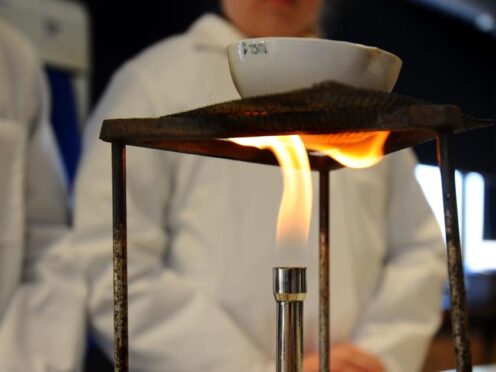
Pupils have less access to interactive science practicals as video demonstrations are being used instead, a report has suggested.
A survey, commissioned by the Royal Society and EngineeringUK, found that just over a quarter (26%) of GCSE pupils reported doing hands-on practical work in science at least fortnightly.
This was lower than in 2019 (37%) and 2016 (44%) when Year 10 and 11 pupils were surveyed on the frequency of practical work, according to the report.
There has been a “marked shift away” from more interactive forms of practical work as videos of practicals are increasingly being used as a replacement – and the Covid-19 school lockdowns may have contributed to the trend, it said.
A poll of 7,256 pupils aged 11–18 in state schools and colleges in England suggests nearly half (46%) of GCSE pupils surveyed said they watched a video of a practical at least fortnightly.
This was higher than those surveyed before the pandemic in 2019 (41%) and in 2016 (39%).
Among all students surveyed in Years 7–11, the most common form of exposure to practical science was via video, the report said.
The survey, carried out by Verian between July and September 2023, suggests that 68% of Year 10 and 11 students want to do more practical work in science – and the figure is higher among all the pupils surveyed (71%).
There has been a “negative shift” in young people’s engagement and participation in science at school since 2019 and it is “likely” that disruption from the pandemic may have contributed, the report said.
Addressing the increasing use of videos of practicals, it added: “While it is possible that these changes are symptomatic of a longer–term shift towards using digital technology as a replacement for hands–on work, it is likely that the pandemic has accelerated any such shifts and could mean that digital teaching practices introduced during lockdowns have now become more embedded.”
The report, commissioned with support from Wellcome, also suggested young people are less interested in science and computing than in 2019.
It said experience of hands-on practical work is “key to motivating students in science” – especially among the least engaged in science.
Professor Ulrike Tillmann, chairwoman of the Royal Society’s education committee, said: “The wonderful thing about science is that it has a practical side. It is not just in your head, you can touch and feel it, whether in the classroom or as part of everyday life.
“Access to effective hands-on learning that students can tangibly connect to the real world will help make science feel more relevant and meaningful and provide valuable skills for life and work.
“The present situation means many young people may emerge from school without a sound appreciation of scientific methods, which are crucial for understanding how science works and being able to engage with scientific issues.”
Dr Hilary Leevers, chief executive of EngineeringUK, said: “We need hundreds of thousands more people entering STEM (science, engineering, technology and mathematics) careers to get on track to meet net zero, to improve sustainability, and for the UK to prosper.
“The evidence of a declining interest in science is a serious wake-up call.”
Pepe Di’Iasio, general secretary of the Association of School and College Leaders (ASCL), said: “The equipment necessary for experiments, including chemicals in some cases, can be prohibitively expensive for schools battling exceptionally tight budgets.
“Practical work often requires the help of a specialist technician as well as additional planning and risk assessment from the teacher, who will already be working within the confines of a timetable that is likely bursting at the seams.
“All of this can lead to teachers taking the difficult decision to use video demonstrations as opposed to their preferred option of enabling students to experience experiments first hand.”
Sarah Hannafin, head of policy at school leaders’ union NAHT, said the Government’s “obsession” with exams may be contributing to the decline.
She said: “In part, this decline in students having the opportunity to take part in experiments may be due to shortages of specialist science teachers or technicians at a time when schools are facing a severe recruitment and retention crisis.
“But it may also reflect government reforms which saw a new approach of assessing practical work using written exam questions rather than through controlled assessment.”

Enjoy the convenience of having The Sunday Post delivered as a digital ePaper straight to your smartphone, tablet or computer.
Subscribe for only £5.49 a month and enjoy all the benefits of the printed paper as a digital replica.
Subscribe